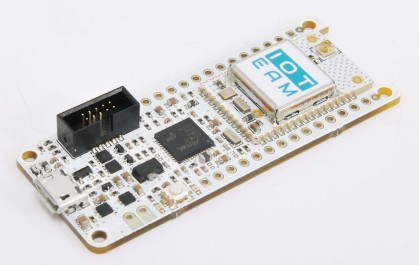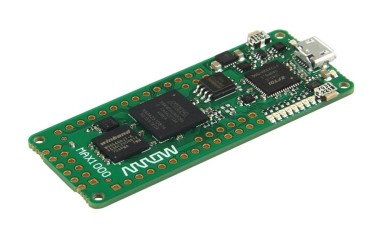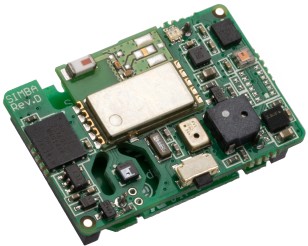Arrow Board Raffle: looking for a free FPGA dev board?
September 20, 2018
on
on
Arrow Electronics supports start-up companies and design engineers with a suite of development boards intended to speed up product development. This week again we present you four of these boards. Even better, we are giving them away for free! If you would like to have a chance to get one of these for free just fill in this form. The lucky winners will receive the board of their choice for free, no strings attached!
Who said that size doesn’t matter? It does. Many sexy applications prefer small boards, especially the long-endurance ones. The boards in this week’s selection are like that. Some of them sport an FPGA, others have ARM-core processors; they all let you express yourself the way you want on a small surface while consuming little power.
Dustino is a small board intended for Dusty (SmartMesh IP) mesh network applications. It is compatible with the Arduino MKR1000 and has the same form factor. The board comes in two versions: with a PCB antenna (Dustino ITM-DOPA-B-01) or with a U.FL connector (Dustino ITM-DOUF-B-01). SmartMesh IP networking offers better than 99.999% data reliability in Industrial IoT and over 10 years of battery life. Being an Arduino MKR1000 derivative, Dustino is fully supported by the Arduino IDE. Other ARM programming toolchains can be used as well as an SWD port is available for convenient programming and debugging.
More information
Dustino ITM-DOPA-B-01: https://www.arrow.com/en/products/itm-dopa-b-01/arrow-development-tools
Dustino ITM-DOUF-B-01: https://www.arrow.com/en/products/itm-douf-b-01/arrow-development-tools
FPGAs have their place too in IoT and rapid prototyping as is proven by the MAX1000 board. Based on a MAX10 device from Intel it disposes of 8K logic elements (LE), 378 Kbit RAM, 1,376 Kbit Flash memory, an 18 × 18 bit multiplier, and an ADC. With this feature set it is capable of running a 32-bit Nios II softcore microcontroller including I2C or SPI port, making it accessible to FPGA novices while not excluding the experts. The MAX1000 is supported by the free Quartus Prime Lite development tool suite. Programming the board can be done either over JTAG or simply by using the on-board Arrow USB Blaster.

The CYC1000 board looks very similar to the MAX1000 board, yet it is completely different. The reason for this is its Cyclone 10 device from Intel, comprising 24K logic elements (LE), 594 Kbit RAM, and an 18 × 18 bit multiplier (or two 9 × 9 bit multipliers). A complete suite of DSP IPs for algorithmic acceleration is available, making this board a signal processing powerhouse. Of course it is capable of running a 32-bit Nios II softcore microcontroller including I2C or SPI port. The CYC1000 is supported by the free Quartus Prime Lite development tool suite. Programming the board can be done either over JTAG or simply by using the on-board Arrow USB Blaster.

When it comes to size and power, Simba-Pro may be the board you need. It is the fully equipped baseboard from the SensiBLE IoT system-on-board (SoB) family with Bluetooth (BLE) and eight sensors. Based on an ARM Cortex-M4 based 32-bit low-power microcontroller from ST it also has a red/green LED, a user button, and a buzzer. It even comes with a 4 Mbit AT25XE041B flash memory to store data. The module that can be powered from a coin cell works down to two volts and can communicate with the IBM Watson IoT cloud platform. It measures only 20 × 30 mm so it can fit in almost anything.
Who said that size doesn’t matter? It does. Many sexy applications prefer small boards, especially the long-endurance ones. The boards in this week’s selection are like that. Some of them sport an FPGA, others have ARM-core processors; they all let you express yourself the way you want on a small surface while consuming little power.
Dustino

Dustino is a small board intended for Dusty (SmartMesh IP) mesh network applications. It is compatible with the Arduino MKR1000 and has the same form factor. The board comes in two versions: with a PCB antenna (Dustino ITM-DOPA-B-01) or with a U.FL connector (Dustino ITM-DOUF-B-01). SmartMesh IP networking offers better than 99.999% data reliability in Industrial IoT and over 10 years of battery life. Being an Arduino MKR1000 derivative, Dustino is fully supported by the Arduino IDE. Other ARM programming toolchains can be used as well as an SWD port is available for convenient programming and debugging.
| MC | Microchip SAMD21G18A-48 ARM Cortex-M0+, 32 MHz, 32 KB RAM & 256 KB Flash |
| Connectivity | USB, Dusty SmartMesh IP |
| Dustino ITM-DOPA-B-01 | PCB antenna |
| Dustino ITM-DOUF-B-01 | U.FL connector |
| Extension | Arduino MKR1000 connectors |
| Power | Barrel jack, USB, 3 V battery (e.g. 2x AA) |
More information
Dustino ITM-DOPA-B-01: https://www.arrow.com/en/products/itm-dopa-b-01/arrow-development-tools
Dustino ITM-DOUF-B-01: https://www.arrow.com/en/products/itm-douf-b-01/arrow-development-tools
MAX1000

FPGAs have their place too in IoT and rapid prototyping as is proven by the MAX1000 board. Based on a MAX10 device from Intel it disposes of 8K logic elements (LE), 378 Kbit RAM, 1,376 Kbit Flash memory, an 18 × 18 bit multiplier, and an ADC. With this feature set it is capable of running a 32-bit Nios II softcore microcontroller including I2C or SPI port, making it accessible to FPGA novices while not excluding the experts. The MAX1000 is supported by the free Quartus Prime Lite development tool suite. Programming the board can be done either over JTAG or simply by using the on-board Arrow USB Blaster.
| Brain | Intel MAX10 10M08SAU169C8G, 8K LE, 4.75 KB RAM, 172 KB Flash (suitable for Nios II 32-bit MCU softcore) |
| On-board memory | 64 Mbit SDRAM, 64 Mbit Flash |
| Connectivity | USB |
| Sensors | 3-axis accelerometer |
| Extension | Arduino MKR connectors, PMOD, User I/O |
| Programming | JTAG, USB Blaster |
| Power | USB |
More information
MAX1000: https://www.arrow.com/en/products/max1000/arrow-development-toolsCYC1000

The CYC1000 board looks very similar to the MAX1000 board, yet it is completely different. The reason for this is its Cyclone 10 device from Intel, comprising 24K logic elements (LE), 594 Kbit RAM, and an 18 × 18 bit multiplier (or two 9 × 9 bit multipliers). A complete suite of DSP IPs for algorithmic acceleration is available, making this board a signal processing powerhouse. Of course it is capable of running a 32-bit Nios II softcore microcontroller including I2C or SPI port. The CYC1000 is supported by the free Quartus Prime Lite development tool suite. Programming the board can be done either over JTAG or simply by using the on-board Arrow USB Blaster.
| Brain | Intel Cyclone 10 LP 10CL025YU256C8G, 24K LE, 74.25 KB RAM (suitable for Nios II 32-bit MCU softcore) |
| On-board memory | 64 Mbit SDRAM, 16 Mbit Flash |
| Connectivity | USB |
| Sensors | 3-axis accelerometer |
| Extension | Arduino MKR connectors, PMOD, User I/O |
| Programming | JTAG, USB Blaster |
| Power | USB |
More information
CYC1000: https://www.arrow.com/en/products/cyc1000/arrow-development-toolsSimba-Pro

When it comes to size and power, Simba-Pro may be the board you need. It is the fully equipped baseboard from the SensiBLE IoT system-on-board (SoB) family with Bluetooth (BLE) and eight sensors. Based on an ARM Cortex-M4 based 32-bit low-power microcontroller from ST it also has a red/green LED, a user button, and a buzzer. It even comes with a 4 Mbit AT25XE041B flash memory to store data. The module that can be powered from a coin cell works down to two volts and can communicate with the IBM Watson IoT cloud platform. It measures only 20 × 30 mm so it can fit in almost anything.
| Brain | STmicroelectronics STM32L476RG ARM Cortex-M4, 80 MHz, 128 KB SRAM, 1 MB Flash |
| On-board memory | 4 Mbit Flash |
| Connectivity | Bluetooth BLE 4.1, USB ready |
| Sensors | Temperature, humidity, 3-axis accelerometer, 3-axis gyroscope, 3-axis magnetometer, pressure, microphone, light (colour, IR, ambient) |
| Extension | 13-pin connector, 14-pin connector |
| Power | 4.5-7 VDC, 2-3.6 V battery (CR2025, CR2032) |
More information
Simba-Pro: https://www.arrow.com/en/products/simba-pro/sensiedgeRead full article
Hide full article



Discussion (1 comment)
mohana shaw 6 years ago